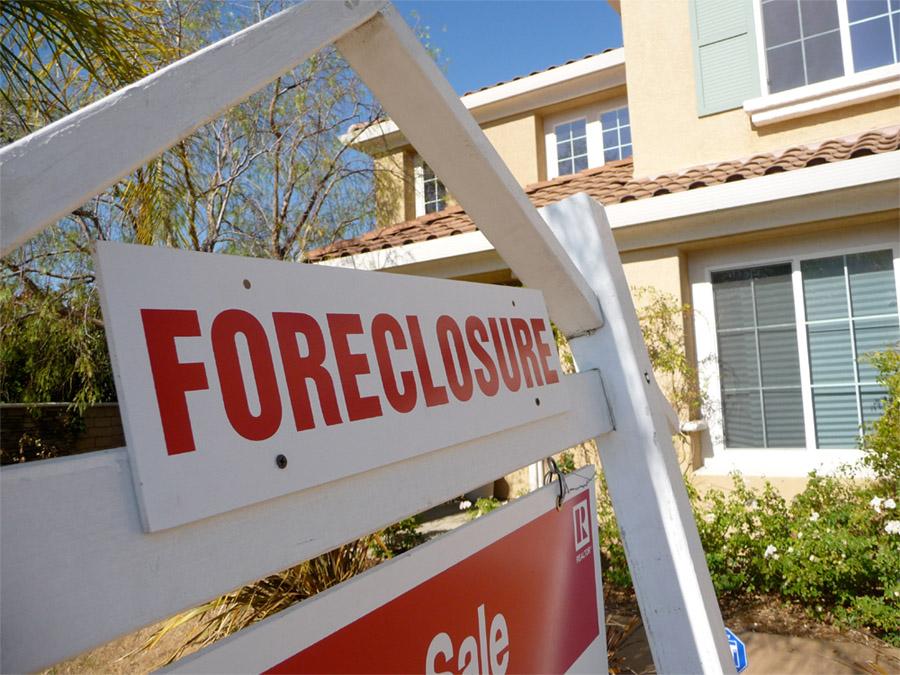
If you’ve ever wondered “What are REO’s?” just talk to John Soforic. He reached financial independence in his 40s after learning how to buy bank-owned properties, and today owns over a hundred of them.
But he certainly didn’t start out that way. At 30, John Soforic was broke. But he had a vision: he wanted to earn $220,000 per year in passive income. So he wrote himself a check for $220,000, which he set aside where he would see it.
That vision became a reality, and as he earned more money from rental properties, he semi-retired from his career as a chiropractor in his mid-40s.
If you want to learn how to buy bank-owned properties, take the next five minutes to learn exactly how John reached financial independence and retired early (FIRE) with REO properties.
What Are REO’s?
Short for “real estate owned,” REO properties are bank-owned properties that the lender took back at foreclosure.
Most properties don’t actually sell at foreclosure auction. Mortgage lenders typically set the starting bid at the balance they’re owed — which is usually more than the home is worth. So no one bids, and the bank ends up taking the property back.
After a lengthy legal process to change the ownership on the deed over to the lender, including a title search and transfer, the bank contacts a local real estate agent. The Realtor inspects the property, and advises the bank whether they should sell the property as-is or repair it.
Eventually, most REO properties get listed for sale on the multiple listing service (MLS). However you can sometimes get access to a lender’s REO list before other potential buyers, if you develop a relationship with their REO manager.
Getting Started with REO Property Investing
I asked John about his very first deal: how he bought it, the purchase price, cash flow, all the usual questions. Before getting into the details, he took pains to explain how seriously he took his real estate education.
“For a year, I studied rental real estate investing as if it were an occupation. I immersed myself in podcasts, audiobooks, and every book I could find. I especially immersed myself in all things related to estimating renovation costs, appraising real estate, calculating rental cash flow, and calculating after-repair value of renovated properties.”
Because if the numbers don’t work, if you have negative cash flow on a rental property or lose money on a flip, that’s where you run into the worst trouble as a real estate investor. It’s why we offer a free rental cash flow calculator, and take such pains to educate investors on accurately forecasting cash flow.
“What I’d like to stress is that I treated this like a college education to gain competence before I entered the game. I studied for ten hours a week for a year. It was especially helpful to follow several real estate forums and groups to learn how to buy foreclosures, reading the questions and answers of other real estate investors.
“But then there came a time when it was no longer productive to study. It was time for action.
“I called a real estate agent and set up an appointment to look at a pair of duplexes. And that started a process of me calling agents, looking at properties, and pretending like I knew what I was doing. My goal was to become familiar with looking at rental properties without buying anything too soon.”
John knew the importance of learning real estate investing theory. And its limitations, understanding that there’s only so much you can learn from reading. At a certain point, you have to go out and start looking at properties for yourself.
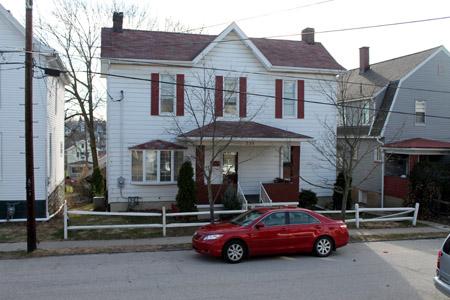
“My first foreclosure property, on Painter St.”
John’s First REO Property
“I entered a single-family house listed at $39,000. It was a bank-owned property taken back after foreclosure, listed on the MLS. I was looking for a house that seemed to be a mismatch (in terms of price) for the street. The street in this case was lined by houses that had sold for $75,000.
“What I recall most was that I couldn’t find anything wrong with this house. It jumped out at me as a no-brainer. Compared to all other houses, it was a gem. And I sensed that even the Realtor was getting interested in this house as we inspected it. Having never bought an investment property before, I was tempted but scared to make an instant offer.
“The house sat on a solid street of blue-collar houses in a blue-collar town. It had a decent location, within walking distance to the local hospital. I slept on it, and the next day I made an offer on the house. I gave them the full asking price of $39,000.”
John bought the bank-owned property and updated it using cash from his own savings. “I used cash for repairs that amounted to another $7,000 for carpeting, windows, painting, new lights fixtures. After repairs, the house appraised for $72,000. I refinanced with a rental property loan of $40,000. And with rent at about $650, I netted about $200 monthly.
“So in the end, I invested around $46,000. I then refinanced to take back $40,000 with a 30-year mortgage. My cash-on-cash return therefore was around 40%: $2,400 / $6,000 = $40% return.”
Granted, those numbers don’t include his closing costs. But if he incurred $4,000 in closing costs, that still puts his cash-on-cash returns at 24%.
All of which sounds great, but John made a classic rookie mistake: he glossed over the tenant screening process. “I accepted the first tenant who applied, who turned out to be a drug addict. He trashed the place, within a year, and I had to put another $5,000 into it.”
Ouch. But John never made that mistake again, and not only runs tenant screening reports but takes other thorough tenant screening measures such as contacting employers, current landlords, and former landlords.
Read about rental property calculator.
Read about lowest down payment for investment property.
How to Buy Bank-Owned Properties
The tenant screening snafu with the criminal tenant notwithstanding, John was hooked. He knew that if he kept buying foreclosed homes like his first one, he’d quickly be able to cover his living expenses and reach financial independence.
As he continued learning about how to buy foreclosures, John also continued setting aside savings. He bought a second bank-owned property listed on the MLS, and then a third. He began to spot patterns with foreclosed properties that lenders had taken back at the auction. “My strategy was to get bank-owned REOs as soon as they came on the MLS.”
Why wait? Why not buy them at the initial foreclosure auction?
“I’ll never understand it, but the banks would take back a house with a $100,000 mortgage on it. If I asked how much they’d sell it for, they’d say $100,000 of course. It was rarely worth the amount of the mortgage in its present condition, and so I’d wait. And then it would come on the MLS at $45,000.”
Other investors buy foreclosures before they go to public auction. They find these distressed homes earlier in the foreclosure process using tools like Propstream or Foreclosure.com, such as the local properties below:
Bear in mind that many of these properties need extensive repairs. Make sure you include a home inspection contingency in your contract of sale.
You don’t have to worry about some other headaches though, such as dealing with the previous owner or outstanding taxes. When the bank retakes ownership at the foreclosure sale, they have to catch up on the property taxes and pay off all tax liens.
Eventually, John ran into the most common challenge in real estate investing: capital.
How to Buy Bank-Owned Properties with Financing
“The greatest riddle to solve is where do we continue to find the cash to invest? My formula seemed to be to invest cash (savings) into a distressed property, fix it up, and take cash back out with a long-term rental property loan.” A strategy you might already know: the BRRRR method of real estate investing.
Note that he didn’t use Fannie Mae mortgages for rental properties, which appear on your credit report and can impact your credit score. He used rental property loans through specialist lenders like Visio, Kiavi, and Patch Lending.
“I’d usually leave about $10,000 in each investment property. But after about 15 rentals I was broke.
“I worked full-time to earn living expenses. At the time, my rentals earned about $200 per month apiece, multiplied by 15 equals about $3,000 per month. My first step to get more money was to cash out my 401(k) savings with severe penalties. This gave me enough money to continue investing for a few more years.
“At about 20 units I was broke again. So I needed to start flipping houses to generate profits for more rentals. But being broke, where could I find the money?”
John started with equity in his home, with a home equity line of credit (HELOC). And yes, for reference you can get HELOCs on rental properties! Try Figure for a fast settlement within five days.
Then he turned to a business line of credit. To maximize the credit line, he put up equity in his existing real estate portfolio as collateral. But keep in mind that you can also open a series of unsecured credit lines; check out business credit line concierge Fund & Grow for help in doing so.
“Using leverage in real estate like this was a bit more dangerous, but I was a cautious investor with my deals. Debt is like fire; it can heat a house safely if it is contained, but it can burn a house down if it is not. I kept my debt contained, and I now had the power of capital behind me. With these two credit lines, I flipped 5-6 houses a year and added at least one rental to my portfolio each year, while I continually worked a full-time job.”
How to Buy an REO Property Without a Mortgage
Now that John had mastered how to buy bank-owned properties and started flipping houses to help fund his portfolio growth, he had plenty of capital to work with. He would earn a hefty paycheck by flipping a home, pay off his credit lines, and go out and do it all over again.
“I always knew one of these flips would end up becoming my new home. My wife was watching these foreclosure listings too closely, and it was a matter of time before she saw one she liked.
“A bank-owned home came on the market at $220,000. A month later, the price dropped to $180,000.
“I made an offer for $75,000. The bank refused to even respond to such a lowball offer. Until, that is, the end of the year arrived in December. They asked the listing agent if my offer was still on the table. I was floored. For some reason, the banks wanted this house off the books by the end of the year.
“I signed the contract that very day and bought the house for $75,000. It needed another $75,000 of work to make it exactly how we wanted it, but then it appraised for $225,000.
“I used one of my business credit lines to cover the costs. By the time we finished the renovation, a few other flips had sold which allowed me to pay back the line of credit. We still live in this house today without a mortgage payment.”
Hard Lessons in Managing Contractors
When I interview successful real estate investors, I always ask what hasn’t gone according to plan. What went wrong, what lessons they ended up learning the hard way.
You’d be surprised how many of those hard lessons revolve around contractors.
“Contractors will tell you they need cash up front to buy materials. Don’t give it to them. You should buy your own materials, or let them order materials on your account at Lowe’s or Home Depot.
“And always, always withhold a large chunk of payment until the job is completed and it satisfies you. No amount of contractor excuses and ‘crying for the final payment’ should sway you on this critical point.”
Learn from other investors’ mistakes! Always insist on these terms, when you negotiate with contractors.
“Twice I prepaid contractors — and both times I cussed myself out after losing the money. NEVER, NEVER, NEVER prepay the contractor. I wouldn’t prepay my own mother in this business.
“When you give them the money, you give away any leverage you have over them.”
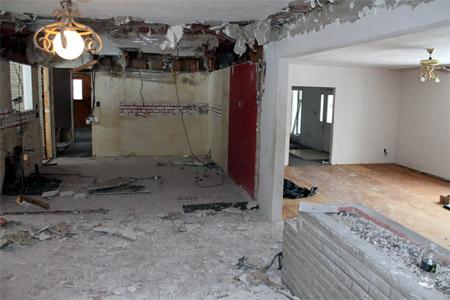
“The kitchen renovation in ‘The Titanic’.”
The Low Point of John’s Foreclosure Investing Career
Every story arc has a low point. The moment when all hope seemed lost.
“I was in a foreclosure purchase late at night, alone, and I just lowered myself to a knee and sobbed. This was after three consecutive flips that barely made any profit. I’d recently fired my contractors, again, and this particular house was the most distressed property I’d ever seen.
“In fact, the team I fired had called it the Titanic. As in, we’d have to raise this one off the bottom!
“I’m a believer of a positive mindset, and I went home to regain my focus. I needed to focus on winning the inner game. My goal was to regain my vision, my power, and lose the overwhelming self-pity.
“So on my computer I created a flyer of that house, to be used when it was for sale. The following is my statement verbatim, exactly as I wrote it out that day:
“Three-bedroom ranch, three ceramic tile showers, amazing new kitchen and island with granite countertop, jacuzzi, new roof with skylights, new hardwood floors, new plumbing and electrical, new furnace and gas fireplaces, outdoor whirlpool, new stone patio, new windows — all new EVERYTHING!”
“I created this written description to shape future reality. And I did it to reclaim my power. I also copied online pictures to put in the flyer, and I tacked this onto a wall so I’d see it every day.
“It took a while, but we finished renovating the Titanic. And it sold for a $50,000 profit, starting a new phase of momentum that led me to the end goal of financial independence and retiring early.”
Balancing a Career, Real Estate Investing, and Family Life
For many years, John worked full-time as a chiropractor. When he wasn’t working at his full-time job, he was looking for a better edge in how to buy foreclosures, or actively investing in real estate.
“I’ve been married for 30 years, and we raised two children. My wife stayed home with the kids and so my income was our total household income.
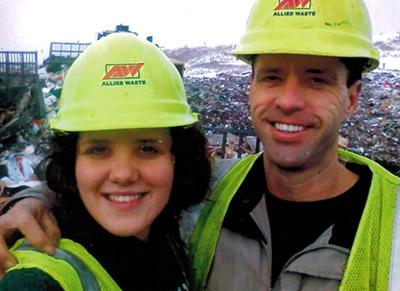
“My daughter and I at the dump, after cleaning out a foreclosure property.”
“Like all parents, I struggled with work duties and family responsibilities. Some people say that they can’t give their free time to work because they have a family. Well, I had a family, too. And I sacrificed my free time because of my family; it was my responsibility to provide and protect them.
“What I did right, I think, is communicate openly and honestly. My wife and kids knew my financial fears and my dreams. They knew why I was working in my free hours, and how it would benefit the family.
“My kids have since graduated from college without debt, but I first gained their support with courteous communication. I treated them as equals, and they understood my sacrifices. My son once told his friends about the honesty of our relationship, and they said they envied him. So, it can be done.”
But that doesn’t make it easy. It takes a clear vision, ongoing motivation and discipline, and most of all the support of your family.
Reaching Financial Independence & Retiring Early
“I semi-retired retired from chiropractic at 45, at which time I gave more hours to real estate. I could have stopped at age 45, when I had roughly $140,000 in passive rental income, but I would have had no margin of safety. What about future calamities?”
But with the extra hours put toward his real estate investing business, John made rapid progress on building more rental income. “I fully retired four years later at 49, after I’d reached my life goal of $220,000 in passive income.”
John still does some foreclosure property investing to this day, mostly because he enjoys it, and brings in over $20,000/month in net rental income. He’s built strong relationships with rental property lenders, contractors, property managers, Realtors, and many others in the industry. Relationships that keep him in easy financing.
“Keep in mind, the banks love me now, but I’m not sure they would have loved me so much without a job and a steady income. So my job was part of my real estate strategy.”
Even so, reaching FIRE has helped John focus his energy elsewhere. “I wrote a book about my experiences in real estate investing, and how I passed those lessons on to my children. My book, “The Wealthy Gardener: Lessons on Prosperity between Father and Son,” became an Amazon bestseller, and got picked up by major publishing house. It’s being relaunched by Penguin next month.”
Final Pieces of Advice for How to Buy Bank-Owned Properties
What are REO’s? Golden geese, according to John Soforic.
“I always liked this story about a guy I knew. In his late forties, after his kids left the house, his wife demanded a divorce. They had an acrimonious settlement over their assets. Finally, they agreed that she would get his entire life savings and he would keep the rental units, which she never liked anyway—it was just headaches and hassles to her.
“When later asked about this deal, which seemed to favor her side so dramatically, the man chuckled knowingly, ‘Well, she may have gotten the golden eggs. But I got the geese.’
“My advice is very basic. Never forget in the end, it’s about cash-on-cash return. Real estate is an investment vehicle. Don’t fall in love with the property – fall in love with the deal. And don’t listen to anyone who tells you it’s about location, location, location. That’s total crap. Sometimes the best locations are the worst deals, not unlike an overpriced stock. Be patient and wait for the best deal.
“In my opinion, you have to be both cautious and bold. Courage without caution is a bus without breaks. Caution without courage is a bus without keys. You need courage and caution in the right measure.”
Put more directly: use courage to aggressively find deals, and to find the money to pay for them. Use caution to diligently scrutinize those deals, to make sure they will cash flow well.
Do that, and you too can create $20,000/month in net rental income.
Read llc mortgage loan requirements.
Read does california have rent control?
Have you ever bought foreclosed houses or bank-owned properties? What questions do you have about how to buy an REO property?
More Real Estate Investing Reads:
About the Author

G. Brian Davis is a real estate investor and cofounder of SparkRental who spends 10 months of the year in South America. His mission: to help 5,000 people reach financial independence with passive income from real estate. If you want to be one of them, join Brian and Deni for a free class on How to Earn 15-30% on Fractional Real Estate Investments.

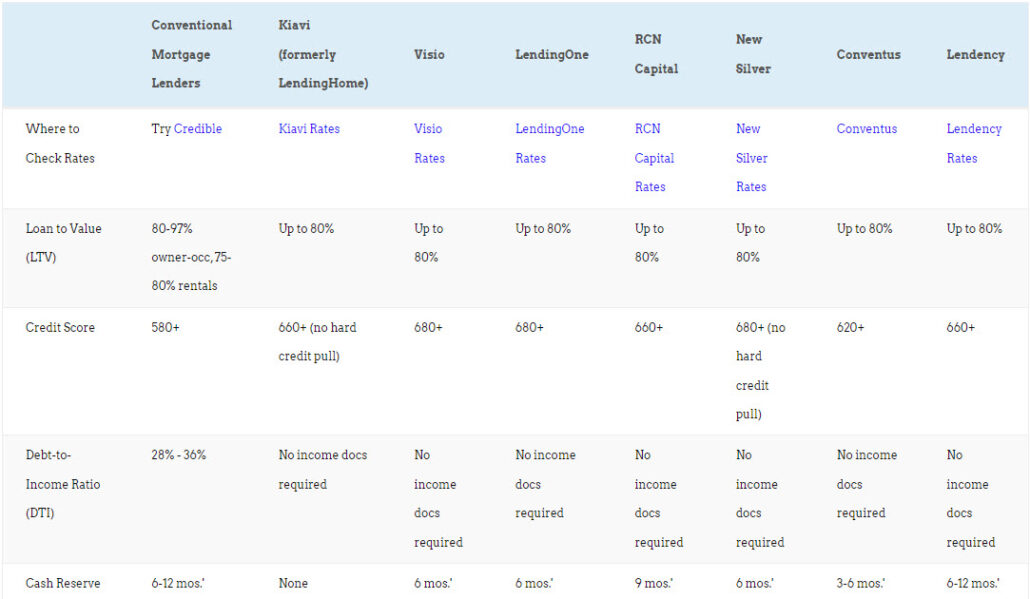
























This is the kind of strategy I’ve been trying to follow as a brand new investor but I’m not sure if it’s a viable strategy in he current market, or at least in my area. It sounds like John waits for a foreclosure to come on the market then buys it immediately. But in my area the competition is so high that when a great deal comes on the market it receives 10+ bids within a day or 2 and most are over asking price.
I’m not sure if I’m missing something about his strategy. It doesn’t sound like he buys the property at the auction but waits for it to be taken back by the lender then listed.
That strategy may have to wait until the house market goes back down.
Different strategies work better in different markets. If there’s too much competition for on-market deals in your area, I’d look for off-market deals through a tool like Propstream or Deal Machine. See our article on how to find off-market real estate deals for more ideas.
Good article Brian. As a full time teacher AND full time investor, with a family, I definitely empathize with this man’s journey.
Thanks Dylan! It’s definitely hard to find all the hours in the day that you want, especially with a family. One reason why I pursue financial independence!
I currently live in Denver, CO and have no idea how to get into another house. It’s almost like living in San Fran with prices like these.
Yeah the Front Range has gotten outrageously expensive. Victim of its own success, as a place with high quality of life.
But hey, at least you don’t have the homeless problem that San Francisco has!
I’m not going to lie, its getting pretty bad but nothing really like what happens over there. I went to SF two years ago and couldn’t believe what I was seeing.
I agree, being cautious and bold are the key to success! Be disciplined on taking actions. I’m inspired to do the same strategy!
Disciplined action, here here!
I’m also interested in buying foreclosures and I find this inspiring! However I don’t have enough funds to start investing. I’m still on the stage of hoarding real estate learning materials.
It’s important to learn before you invest Mark! Just make sure you have a timeline for taking action. You don’t want to get stuck in analysis paralysis!